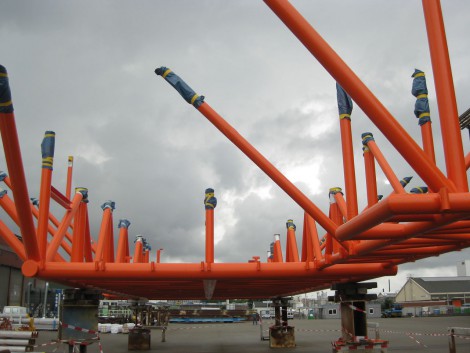The most durable protection for your investment. Do you want to know more about metallizing? Contact us on +31 (0)168-412750 or use the contact form.
Metallizing techniques
A wire is continuously melted in an electric arc spray or gas flame spray gun, much like welding. The molten metal is atomised with compressed air and propelled onto the workpiece, where it solidifies on the surface to form a dense, strongly adherent coating (10 MPa and above), which normally varies between 200 and 400 microns. A paint sealer is subsequently applied which penetrates into the pores and completely seals the underlying steel.
DCS uses two techniques:
- Flame spraying: a metal wire is melted with a combustion flame of fuel gas and oxygen.
- Arc spraying: two wires are charged and an arc generated between them, which causes the tips of the wires to melt.
The advantage of flame spraying is that the equipment is more mobile than the installations used for arc spraying, making metallizing also possible on location.
The most durable protection for your investment
Wet painting systems are often based on alkyd resin, epoxy or polyurethane paints. As an alternative to paint, it is also possible to protect steel with a thin layer of pure aluminium, zinc or a metal alloy. This is called metallizing, also referred to as TSA thermally Sprayed Aluminum, metal spraying or flame spraying. The large advantage of metallized coatings over painted coatings is the long-lasting quality: the protective film has a very high bond strength and is extremely hard. Your investment is guaranteed protection from corrosion for up to 50 years. A big difference to painted coatings, which have to be reapplied frequently. Another commonly used term for this technique is Thermally Sprayed Aluminium (TSA).
Application areas
Due to the superior durability of metallizing, it is increasingly applied in the offshore industry, civil engineering, industrial sector and petrochemistry. DCS introduced the technique to the Netherlands and large public organisations, such as the Department of Waterways and Public Works and ProRail, make frequent use of it. Examples of works metallized by DCS include the Netkous, the light rail flyover along Prinses Beatrixlaan in The Hague, the noise barrier near Dordrecht, the railway bridge in Nootdorp and the floodgates at Krimpen aan den IJssel.
Tailored advice
Naturally, DCS would be glad to assist you in making a well-informed choice between the various metallizing and wet painting techniques.

